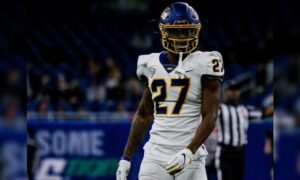By Alex Kozora
A Hollywood blockbuster has nothing on the NFL Draft. It’s become the main event in football’s offseason. Almost immediately as one team raises The Lombardi Trophy, the focus switches to the draft.
Months of pre-draft discussion. Obsessing over the most minute of details – run a 4.71? Uh oh, your stock is slipping. Then 30 players are rounded up and invited to New York to sit awkwardly in a green room until their name is called. Tom Savage was invited to the 2014 Draft. An event so massive two networks broadcast a podium for three days.
Internally, there’s just as much depth. The amount of preparation teams go through borders on insanity. There should be a series on TLC dedicated to it. No stone is left unturned, no player falling through the cracks. Remember when a Buffalo Bills’ scout found Michael Jasper, a player most forgot about, at a NAIA school and could only get an accurate weight by putting him on a scale at a local feed store?
The NFL Draft is a big deal inside and out. But it wasn’t always that way. Certainly not in 1956. And that’s when the Pittsburgh Steelers made a little bit of history – and infamy.
They would take defensive back Gary Glick with the first selection in the 1956 draft. If that name doesn’t sound familiar, don’t feel alone. The Steelers didn’t know it either.
Glick was born in Grant, Nebraska but moved to Colorado. First to Lakewood, then the small town of Laporte – 70 miles outside of Denver – where his family bought a dairy farm.
He weighed 163 pounds after graduating high school in 1947, light even for the times. He delayed going to school, choosing to join the Navy instead. There he added over 20 pounds and when given the chance to scrimmage against NFL squads, caught the eye of colleges. The Navy named Glick athlete of the year in 1952.
He chose Colorado A&M – now Colorado State – later that year, becoming a multi-purpose athlete on the football field. While he’s listed as just a running back on the team’s all-time roster, his college coach Bob Davis quipped that Glick did everything “but punt.”
He was not the first nor last Glick to attend CSU, two brothers played before and one after, but arguably the most successful.
His list of accomplishments include a team-high eight interceptions in 1954, 14 in his career (then a Colorado State record), and was inducted into the Colorado Sports Hall of Fame in 1992.
In 1955, he helped lead the Rams to an 8-2 record, winning the Skyline Conference championship. He ran for eight touchdowns and threw for two more en route to being named to the AP All-American Second Team.
Despite a collegiate career that depicts a better four years than history cares to remember, Glick didn’t garner much attention from the NFL. Perhaps due to geography – no other player taken in the first round that year played west of the Mississippi – or the fact he wore a different jersey number each season.
In fact, his biggest supporter was Coach Davis, sending out letters to the league in the hopes someone would listen.
One of those letters landed on the desk of Pittsburgh Steelers’ head coach Walt Kiesling. Kiesling was at the end of his third and final stint coaching the club. 1956 would be his final year in the NFL, one of many coaches who failed to turn the Steelers’ around.
He fell in love with the words Davis wrote, the college coach proclaiming, “Never in my entire coaching career was I as high on a player as I am on Gary. He simply can’t miss in the pro league.”
From that moment on, despite not knowing anything else about Glick, Kiesling couldn’t be swayed to consider any other prospect.
Pittsburgh obtaining the first overall pick is a story in itself. It was not for having the worst record in the NFL; they were coming off a 5-7 season, not good, but better than three others in the then-ten team league.
Introduced in 1947 before being discontinued eleven years later, the league awarded a “bonus pick” – the first selection via a lottery. It was far from high-tech, simply names picked out of a hat, but then again, this is a league that still uses fax machines and the occasional coin flip to determine draft order.
Prior to the 1956 draft, three teams remained in the lottery: the Chicago Cardinals, Green Bay Packers, and the Steelers. The Steelers caught a lucky break, rare for the franchise, in getting the pick. Dan Rooney wrote about the moment in his book, Dan Rooney: My 75 Years With the Pittsburgh Steelers and The NFL.
“…Bert Bell placed three pieces of paper, one marked in pencil with an X and the letters B-O-N-U-S, into a gray felt fedora. I stood right next to him and saw where he placed the three slips. When it came time to draw, he looked at me and said, ‘Danny, you pick first.’ Of course, I nabbed the bonus pick. Bert wasn’t cheating. Maybe he didn’t realize I was paying such close attention, but in any case, I wasn’t about to let a gift like this pass us by. The Steelers needed all the help we could get.”
The Steelers had the pick. But in Rooney’s mind, they weren’t targeting the right player. He attempted to confront Kiesling about selecting someone other than Glick. Again, from Rooney’s book.
Rooney: “The guy’s okay. But we don’t need to take him as our bonus pick. He’s a sleeper. Nobody knows a thing about him. In fact, we don’t know a thing about him. We don’t have film, nobody’s seen him, all we’ve got is a letter from a coach we’ve never heard of. We’ll take him, if you want, but we don’t need to take him with our bonus pick. We can pick him up in the third round.”
Kiesling: “No, this guy is good and everybody is going to know about him. Everybody will want him!”
With that conversation going nowhere, Dan Rooney made a last-ditch effort to confront his father. But The Chief spurned his son’s concerns, standing by his life-long philosophy of letting the head coach have final say in all decisions.
And so as the 1956 NFL Draft began on November 29th, 1955, the Pittsburgh Steelers selected Gary Glick – listed as a safety – first overall. To this day, Glick remains the only defensive back in history to be drafted with the first pick.
The Pittsburgh Press shared a sentiment many held. “Who? It was a chorus of disbelief. They didn’t take Hopalong Cassady of Ohio State or Earl Morall of Michigan State?”
The Press’ Chester L. Smith, still writing his The Village Smithy columns (he would retire in 1966 after 35 years) made an attempt at optimism in an op-ed entitled, “Give Gary Glick A Chance.” He compared the Glick selection to the Boston Braves signing unknown running back Cliff Battles who went on to have a Hall of Fame career. Of course, Battles wasn’t drafted, and the league wouldn’t hold an organized draft until four years after Battles’ debut.
Attempting to be more positive, The Pittsburgh Post Gazette focused on Glick’s virtues, not his vices. With a cutesy headline that spanned across half the page, “Steelers Click on Bonus Pick, Get Gary Glick,” they grabbed quotes from Davis signing his defensive back’s praises while noting Glick scored all ten points in Colorado State’s victory in the last game of the seasons versus Colorado. A small picture, included here, was featured next to the column.

Back home in Colorado, there was no celebration. No trip to New York or phone call from the team personally congratulating the pick as is the custom today.
Glick got the news from a Coach Davis phone call. Very anticlimactic, very appropriate for the times.
His signing bonus was $2000. To offer some perspective, .03% of the 5.23 million Ryan Shazier received. He bought a truck with it. Used, not new.
As the newest Steeler was preparing to embark on his professional career, the Steelers’ brain trust – business manager Fran Fogarty, Keisling, and Dan Rooney – finally received their first game film of their number one pick.
I could attempt to wax away on what the trio saw, but Rooney sums it up best.
“Our hearts sank. We saw a wind-swept stadium with open seats, no benches for the players to sit on, dogs running across the field. Glick and the Colorado team were okay, a half-decent team. When the film flipped to an end, we went down to see Dad in his office on the first floor. We didn’t say anything, but he could read our faces. ‘So he didn’t look very good, did he?’”
Rooney does make it a point to say Glick was a “good player” and he did play for the Black and Gold until 1959. Glick played in the NFL until 1963, sans a brief coaching stint with the Denver Broncos in 1962.
Still, the only defensive back to ever be drafted first was not just an unknown in media circles, he was an unknown to the team that selected him. In doing so, the Steelers bypassed players like Earl Morrall who would go on to make two Pro Bowls (Morrall was traded to the Steelers in 1957 but shipped to Detroit about a year later for Bobby Layne). Lenny Moore, who amassed over 12,000 total yards and 113 touchdowns in his career, was passed over twice – the Steelers also had the fifth pick, too. That fifth selection went to Art Davis, who would play for just one season before an injury forced him to retire.
Glick’s selection sums up the Pre-Noll Era perfectly. Blind drafting by stubborn head coaches is an awful combination. It still took over ten years for the Steelers to add the proper pieces, chiefly Chuck Noll and Bill Nunn, but choices like this illustrate the journey to arrive at the destination.
Sometimes, the only way to figure out the right way is to deal with the consequences of the wrong way.
There’s no better example than Gary Glick.







